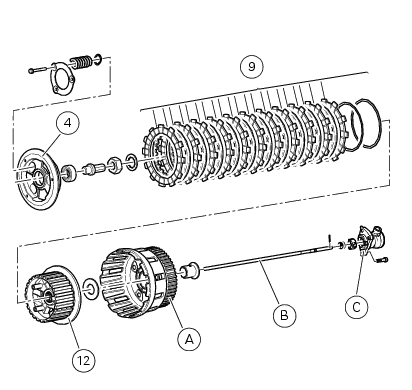
Ducati Diavel Service Manual: Description of the clutch assembly
The clutch is disengaged by a drive unit consisting of a thrust piston (c) accommodated inside a small cap mounted to the generator cover. This piston (c) pushes a pushrod (b), which runs through gearbox primary shaft and operates the Pressure plate (4) located on top of the clutch plate pack (9).
Drive is transmitted from the crankshaft to the gearbox primary shaft by a gear integrated with the clutch housing/primary drive gear pair (a).
Accommodated in the clutch housing is a set of drive and driven plates (9). When the clutch is operated, the driven plates push away a drum (12) which is splined onto the gearbox primary shaft.
Before working on the internal clutch parts, check that the clutch operates correctly. Then deal with the problem in a systematic manner.

The following is a list of possible causes of clutch malfunctions.
A clutch which does not disengage may be caused by:
- Excessive play of the control lever;
- Distorted clutch plates;
- Incorrect spring tension;
- Faulty clutch release mechanism;
- Excessive wear of the hub or clutch drum.
A clutch which slips may be caused by:
- Insufficient play of the control lever;
- Insufficient play of the control lever;
- Weakened springs;
- Faulty clutch release mechanism;
- Excessive wear of the hub or clutch drum.
A noisy clutch may be caused by:
- Excessive backlash between the primary drive gears;
- Damaged primary drive gear teeth;
- Excessive play between friction plate tabs and the clutch drum;
- Worn gear/clutch drum bearings;
- The presence of metal particles (filings) on the gear teeth.
 Clutch
Clutch
Screw
Ring
Clutch spring
Pressure plate
Bearing
Circlips
Nut
Belleville washer
Clutch plates
Belleville washer
Flat ring
Clutch centre
Spacer
Clutch lifter
Spare pa ...
 Removal of the clutch
Removal of the clutch
Note
For clarity, the figures show the engine removed from the frame.
Undo the fixing screws (1) and remove the ring (2) and the springs (3) from
the pressure plate (4).
Slide the pre ...
Other materials:
Lh switch
Dip switch, light dip switch, two positions (fig. 89):
(A) every time pressed down light switches from low
beam on to low beam and high beam
on .
(B) pushed to the side = high
beam flasher (flash),
"start-stop lap" function.
Button = three-position turn
indicator ...
Abs disabled information not displayed
Fault codes
Dds: displays a fault code described in the description of the abs system.
Dashboard: no fault code displayed.
Wiring diagram
Checks
The abs fault indicator indicates the occurrence of one or more faults in the
antilock brake system, or if the system itself
has been disable ...
Total distance covered indicator: "odometer"
This function shows the total distance covered by the vehicle
(in km or miles depending on the specific application).
At key-on the system automatically enters this function.
The odometer reading is stored permanently and cannot be
reset.
If the distance travelled exceeds 199999 km (or 19 ...